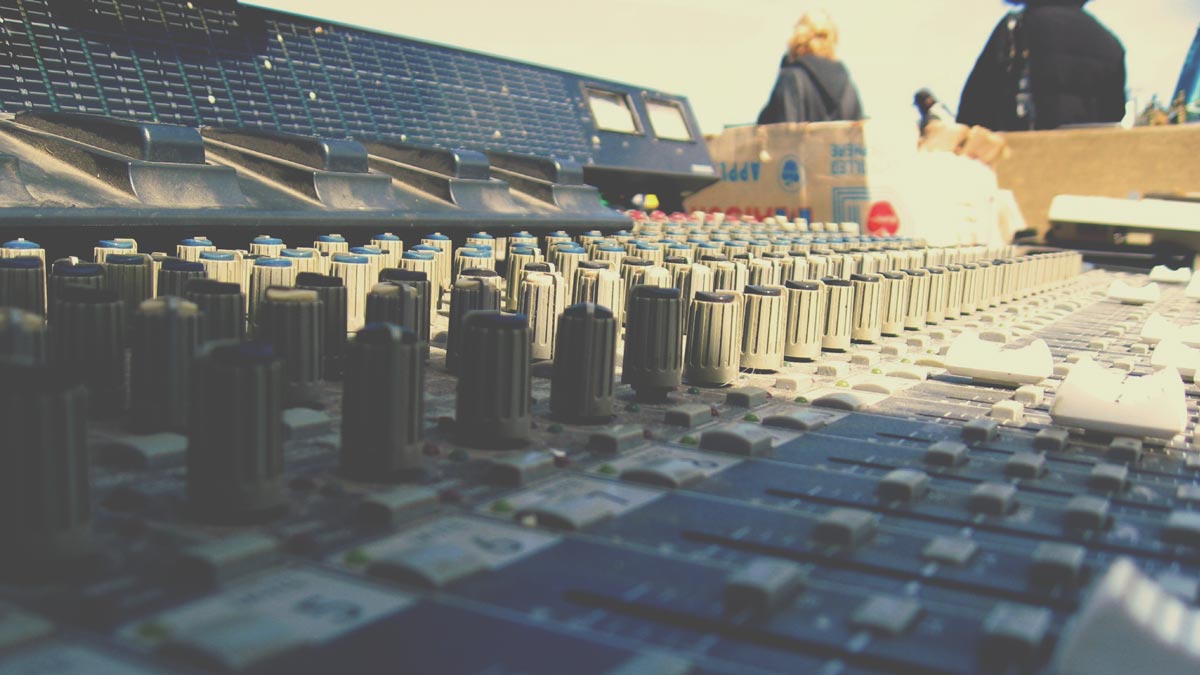
26 Sep 5 Tips That Can Improve Your Mix
We live in an era where high quality media and production is not only a part of everyday life; it’s almost a must. We as a church should not only strive to compete for being the best, but also have the skills to play in the same league as the best. When Gutenberg built his printing press, the first piece of literature printed was the Bible. The Church was the leader of using new technology, not a follower. We should strive for nothing less today!
We as the Church have 52 chances a year to reach people. The better you can be at mixing, the less distracting the experience will be for people. Consistency is a major factor in this. People need to know what to expect from week to week, or mix to mix.
In my experience, I’ve learned that these 5 tips are the main “cornerstones” of being able to properly build a consistent mix anywhere. If you can learn and master these skills, you are going to do well.
1. Preamps
Whenever I walk up to a console, whether I’ve mixed on it before or not, the first thing I check is gain structure. This is the cornerstone of your mix. Most consoles have a visible meter display showing how much input you are receiving from the source. Whoever the console manufacturer is (Midas, Presonus, Behringer, etc.), the console should have a VU meter somewhere that indicates where “unity” or “0” is. Most of the consoles will have a series of green lights, yellow lights, and a single red (or clip) light. The “unity” setting is usually the first yellow light. The new Behringer X-32 “unity” level for example is (-18db). This is designed to give an adequate amount of input with an ample amount of headroom. It’s also the spot where the manufacturer has determined the “sweet spot” is for the preamp. It doesn’t matter if the source is a super loud snare drum, or a quiet vocalist, their input meter should both be set to “unity”. Here’s why, this will help you build a consistency with different worship teams / bands. Lets say drummer 1 hits snare drum harder than drummer 2, but you want your EQ and compression to have the same sound. By simply adjusting the preamp to “unity”, all the other settings will be close to drummer 1.
2. Compressors
I love compression. I could talk about it for hours. I choose not to because I want to keep my friends, but non-the less it’s my favorite tool to use. When it’s used correctly, little to no EQ is needed (generally). There are typically 2 types of compressors. Type 1 has input and output (i.e. Universal Audio’s 1176). This type of compression is achieved by driving the signal into the compressor. Type 2 has a threshold (i.e. DBX 160A or most internal compressors on digital consoles), which is brought down into the signal. For the sake of time, let’s focus on type 2. The compressor components typically include Threshold, Ratio, Knee, Attack, Release, and Gain. All of the components work together to control the signal. If the ratio is set with a 10:1 setting, that means that for every 10 db over the threshold setting, you will get 1 db of output. So, if you set your threshold to -18 and your input spikes up to -8, you will have 10db of gain reduction (GR) from the compressor and only 1db of output signal. Now, the settings for attack and release go hand in hand with the threshold and ratio. The attack setting determines how fast or slow the compressor reacts to the signal hitting the threshold. The faster the attack, the “smoother” the source will sound. The slower the attack, the more “punchy” the source will sound. The release determines how fast or slow the compressor “let’s go” of the signal once it goes below the threshold. Faster releases sound more aggressive where as slower releases sound “cleaner”. If the release is too slow, the source can sound “out of sync” with itself. If it’s too fast, it can sound distorted. The knee determines how “exact” the threshold is. A hard knee will react only when the signal goes above the threshold. A softer knee will react slightly below the threshold. I typically will use hard knee for instruments and softer knee for vocals (but not always). Ok, now that the boring math stuff is out of the way, let’s take a look as to what this baby can do musically. Let’s take the one instrument almost every band or church uses…vocals. What I’m about to tell you is what I like to do. There are plenty of successful engineers and mix guys that use different settings and get amazing results. This is in no way absolute truth, but it does work most of the time for me. So, because vocals are so dynamic, I like to use a 10:1 ratio, fast attack, medium fast release, and has a range of anywhere from -4 to -10db of Gain Reduction. This allows the vocal to have the illusion of dynamics but will keep it from being dynamically inconsistent.
3. EQ (LPF, HPF, Notches, Shelves)
I like to think of EQ as the audio janitor. It cleans up what the compressor missed. A lot of people usually boost frequencies, I do boost certain things, but mainly I use EQ to cut bad or overbearing frequencies. Take vocals for example again. Once the compressor is set and doing its job, I turn the vocal up where I want to hear it. Usually when I do that, there are 3-5 frequencies that are too loud (for my taste). I usually duck out 3 to 6db of lo mids, mids, and hi mids. To generalize, I duck out around 150hz-250hz, 500hz-800hz, and 2.5khz-5khz for starters. These are wide ranges, but it will change significantly between singers. I will typically only boost if there is a frequency missing or lacking. If your EQ looks crazy but sounds correct, there’s something in chain that’s not correct. It could be a wide range of things, having a crazy looking EQ isn’t “wrong” it’s just an indicator that something isn’t right.
4. Microphones
This is one the most important pieces of the mixing puzzle. Think of a contractor. When they show up to a job, they have all sorts of tools to do the job quickly and accurately. Microphones are the sound guy’s tools. If you are working with a singer who is really talented, like they are the next Barbra Streisand, and you give them a microphone with a switch on it that was purchased from radio shack 10 years ago, its not going to sound great. There is a wide range of mic choices for different instruments. There are 4 different types of microphones; dynamic, large diaphragm condenser, small diaphragm condenser, and ribbon. Dynamic mics are good for loud instruments (i.e. drums, amps, horns, sometimes singers). Condenser mics are used when you want a lot of detail (i.e. overheads for drums, string sections, choirs, sometimes singers). Condenser mics require phantom power (48v) unless they have their own power supply. Be careful when using condensers on quiet sources (i.e. finger picking acoustic guitar). You can run the risk of feedback. Ribbon mics are just awesome; they’re my favorite when used correctly. They’re really smooth and silky sounding, but they’re not cheap. They’re used more in recording studios than live, but can still be awesome if you know what you’re doing. Using the correct microphone for the source is key to successful mixing. When the source is mic’d correctly, it makes it easier to “dial in”.
5. FX Choices
Effects are my second most favorite things to use and talk about. However, there are typically 2 problems with mixing with effects. There’s either not enough, or too much of them. Think of effects like makeup. You can make something ordinary sound beautiful, or you can make something beautiful sound ugly or messy. They’re designed to sit in the background of the mix unless it’s a specific moment. Here’s what I like to use if I only have 4 effects slots. I like to have a drum verb, a vocal verb, a vocal delay, and an extra effect. I like to use plate reverbs on drums because they’re brighter and sit nicely in the mix. I will typically use anywhere from 1 to 3 seconds of decay time. The slower the song, the more reverb I use to fill the space in between the notes played. When it comes to vocals, I use reverb and delays together. The more instruments in the mix, the less reverb I use because otherwise it gets too “washy”. I like hall reverbs on vocals, as they tend to be a little darker. It adds a nice ambiance to the vocal without clouding it. As far as delay settings, I like to use anywhere from 30-50% feedback. I will also EQ the delay so that everything above 5k is rolled off and everything below 300hz is rolled off. If you go more extreme with either end, it will sound too “telephone-ish”, thin or bass heavy. When it comes to delay tapping, I will tap the delay usually at a dotted eighth note. However, song tempo plays a role in what I use. I like for the (ms) time to be anywhere from 350-450ms for most of the song. Sometimes, dotted eighths are too slow, so I’ll switch to an eighth note or a triplet; whatever feels the best for the song. I will typically use quarter notes, half notes, and whole notes for echoing single words. I will save the last slot for either a chorus/phaser/flanger effect, or another delay. Chorus can sound cool on vocals or guitars if it’s used correctly. I typically run the speed slowly at either .250ms or at 250hz, with the depth cranked all the way up. This allows the chorus effect to have a wide range but not interfere with the music because it’s moving so slow. Ageneral rule for effects is this: turn it up to where you start to “hear” it, then pull it down a hair. That will ensure it sits in the mix and not take over (unless you want it to do that).
Conclusion
I know that taking some of these things in is like drinking from a fire hose. Here’s what I want you to try, just pick 1-3 things in this whole article and try them out yourself. Then once you have a grip on those, skim through these again and pick out a few more.
Don’t overwhelm yourself and try to tackle all of these at once. Set yourself up for success. If something isn’t working, try something different or go back to what you were doing.
Finally, don’t forget that this is supposed to be fun too. Life is stressful enough; enjoy making music. You are a member of the band. Musicians can rehearse for months, but if there’s someone that doesn’t know what they’re doing on the soundboard, it won’t matter. You hold the keys to make the whole thing great!


No Comments